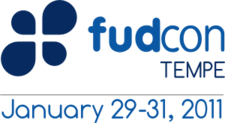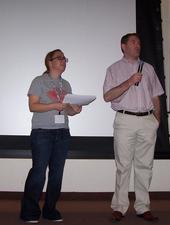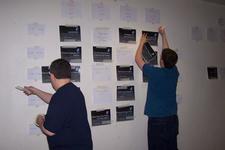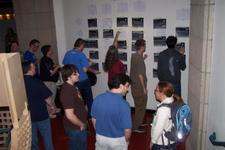Beyond FUDCon: Faces, Features and Future of Fedora
The North American Fedora User and Developer Conference (FUDCon) was held on Arizona State University campus in Tempe Arizona from January 29 -31, 2011 and proved to be the largest FUDCon to date with over 200 people pre-registered to attend and final attendance numbers estimated around 175 people.
FUDCons are free and open events that anyone can attend and are modeled after BarCamps which are known for their unconference style of organization. In other words no one really knows what topics will be discussed until about 2 hours after the attendees are welcomed on the first day of the event (in the case of FUDCons); however, throughout the whole of the FUDCon there were many technical sessions, Lightning talks, Hackfests and social events that give all attendees the opportunity for personal involvement on varying levels and areas of interest.
Upon arriving and presenting ones self at the registration table attendees are given a name badge, lanyard, program. Later in the event attendees are given t-shirts.
Attendees all gathered for the “Orientation” and “Welcome” which at this FUDCon was given by Red Hat’s Community Architecture Leader, Max Spevack. After Spevack’s welcome all attendees who wanted to present a talk were given 30 seconds give to present their topic to all attendees. Once all the topics were presented, the pre-printed and/or hand written topic suggestions on 8.5 by 11 sheets of paper were taped to a wall and “voted” on by all those in attendance. The voting consisted of a 'tick-mark” on the paper of the talk(s) that one was interesting in attending. Once the votes for the talks had been cast, everyone took their seats back in the classroom as Jared Smith the Fedora Project Leader gave the “State of Fedora” annual address. During the address by Smith, other Fedora leaders tallied the votes and put together schedule of talks based on the number of votes each topic received and by the end of Smith’s talk everyone was ready to change locations and get started with the talks that had been selected.
The talks aren’t live streamed or audio broadcast, however, there are some possibilities for remote participation via IRC (Internet Chat Relay) as participants will “record” the sessions and report to the various IRC channels what is being discussed and gather feedback from those IRC participants.
Day one talks included (transcripts of the talks are included where possible): Fedora on ARM, Fedora on OLPC, BoxGrinder, Performance Tuning Basics, Open Source Anthropology, Future Fedora and Reducing Bureaucracy, Sheepdog (Distributed QEMU/KVM block storage), AutoQA introduction, Education übertalk, Cloud: The future of computing, Fedora Security Lab and securing Linux, Different species of Python, What have you done for me lately?, Cloud Filesystem, The Future of Spins, Meet the Anaconda team, Juicy Software Repo Management with Pulp, Cloud management, Using the SELinux Sandbox, Effectively reporting installation bugs, I want to keep on hacking but my hands hurt.
Day Two talks included: AppStream and 10ish Things You Didn't Know about Yum, Fedora Ambassadors, Finance and FOSS in LATAM, Asterisk Hacks, Designing UI mockups in Inkscape, Writing SELinux Policy, IP Law for Hackers, Migrating to open source, GIMP as a pro photo editing tool and Contribute with Knowledge, The Next Big Fedora Engineering Project, Matahari,Usability for UIs. The afternoon of day two also included Lightning talks and various Hackfests.
Day three was all about Hackfests. However, the hackfests were the exchange of ideas and information about a particular subject rather than a bunch of developers hacking on code. Instead it was more akin to a bunch of developers and participants in a roundtable discussing and working on anything pertaining to that particular topic of discussion or area within Fedora.
In addtion to the “traditional” FUDCon event, there was a special celebration Friday night—An Anniversary Party—to celebrate the one year anniversary of Opensource.com. Ruth Suehle was on hand live blogging and promoting the site as well as encouraging participation in opensource.com. Additionally there was pizza, drinks, and cake for all those who attended the celebration.
One interesting moment occurred while speaking to attendee, Randall Hinkley. Hinkley said he had only been using Fedora for about four months. He was from an area near Tempe and while researching setting up his own Fedora sever found the information about FUDCon on the internet and then decided to register and see what it was all about. When I attend events such as FUDCon, it is always encouraging and exciting to see those faces who are new to open source, new to a project, and or new to contribution when they finally meet the people with whom they interact with in an IRC channel or mailing list. While there are some exceptions for the most part these attendees already have a spark in the eye and a hunger for more knowledge about the project, but upon attending events and conferences like a FUDCon find themselves thirsting for ways to contribute as well and Hinkley was no different. He was excited to be there and his personal participation and contribution began to open as he spoke to the various Fedora leaders and community members throughout the event. He wasn’t the only one attending FUDCon for the first time; however, he was the only one I spoke to who was 1) New to the project, 2) Stumbled upon the FUDCon information “accidentally” and 3) Was not already contributing but decided to attend to see what it was all about.
While this is the overview of the a FUDCon in the weeks leading up to the Fedora 15 release, readers will have the opportunity to hear from many of the Faces within the Fedora Community from both Red Hat and volunteer contributors. Each Friday readers will have the opportunity to read and in some cases hear the actual interviews from FUDCon about various projects and the future of those areas within the Fedora Project.
Upcoming Interviews and more:
Interview with Tim Burke, VP of Linux Development at Red Hat. Burke discusses the Red Hat and Fedora cultures and communities, what Fedora represents beyond the operating system, future technologies including including Fedora and RHEL in the Cloud and more.
Opensource.com interview with Ruth Suehle. In this interview you’ll read all about Opensource.com; its history, future and upcoming events that include a leadership webinar with General Hugh Shelton, former Chairman of the Joint Chiefs of Staff who currently serves as chairman of Red Hat's board of directors.
Interview with Paul Frields, Engineering Operations Manager at Red Hat. This interview will be available in audio format. Frields discusses his history with the Fedora project, what he’s doing now and where he sees Fedora’s future.
Interview with Max Spevack, leader of Community Architecture team at Red Hat. This interview will be available in audio format. Spevack discusses his history with the Fedora project as well as what some of the community goals for 2011 look like and what the catalyst for those goals are.
Interview with David Cantrell, Engineer at Red Hat, who talks about the Fedora installer, Anaconda, what it is, its future, and how users can contribute. This interview will be available in audio format as well.
Other upcoming scheduled interviews include Jared Smith, Fedora Project Leader at Red Hat, Robyn Bergeron the new Fedora Program Manager at Red Hat, Ian Weller the “Doer of Stuff” on Community Architecture team at Red Hat several of the Fedora Ambassadors and more.
Mark your calendars and look on your RSS Feeds and join me, Amber Graner, here each Friday as Linux Pro Magazine online brings you a new face, feature, and or future of Fedora.
Photo credit: Mark Terranova
Subscribe to our Linux Newsletters
Find Linux and Open Source Jobs
Subscribe to our ADMIN Newsletters
Support Our Work
Linux Magazine content is made possible with support from readers like you. Please consider contributing when you’ve found an article to be beneficial.

News
-
Linux Mint 22.3 Now Available with New Tools
Linux Mint 22.3 has been released with a pair of new tools for system admins and some pretty cool new features.
-
New Linux Malware Targets Cloud-Based Linux Installations
VoidLink, a new Linux malware, should be of real concern because of its stealth and customization.
-
Say Goodbye to Middle-Mouse Paste
Both Gnome and Firefox have proposed getting rid of a long-time favorite Linux feature.
-
Manjaro 26.0 Primary Desktop Environments Default to Wayland
If you want to stick with X.Org, you'll be limited to the desktop environments you can choose.
-
Mozilla Plans to AI-ify Firefox
With a new CEO in control, Mozilla is doubling down on a strategy of trust, all the while leaning into AI.
-
Gnome Says No to AI-Generated Extensions
If you're a developer wanting to create a new Gnome extension, you'd best set aside that AI code generator, because the extension team will have none of that.
-
Parrot OS Switches to KDE Plasma Desktop
Yet another distro is making the move to the KDE Plasma desktop.
-
TUXEDO Announces Gemini 17
TUXEDO Computers has released the fourth generation of its Gemini laptop with plenty of updates.
-
Two New Distros Adopt Enlightenment
MX Moksha and AV Linux 25 join ranks with Bodhi Linux and embrace the Enlightenment desktop.
-
Solus Linux 4.8 Removes Python 2
Solus Linux 4.8 has been released with the latest Linux kernel, updated desktops, and a key removal.





